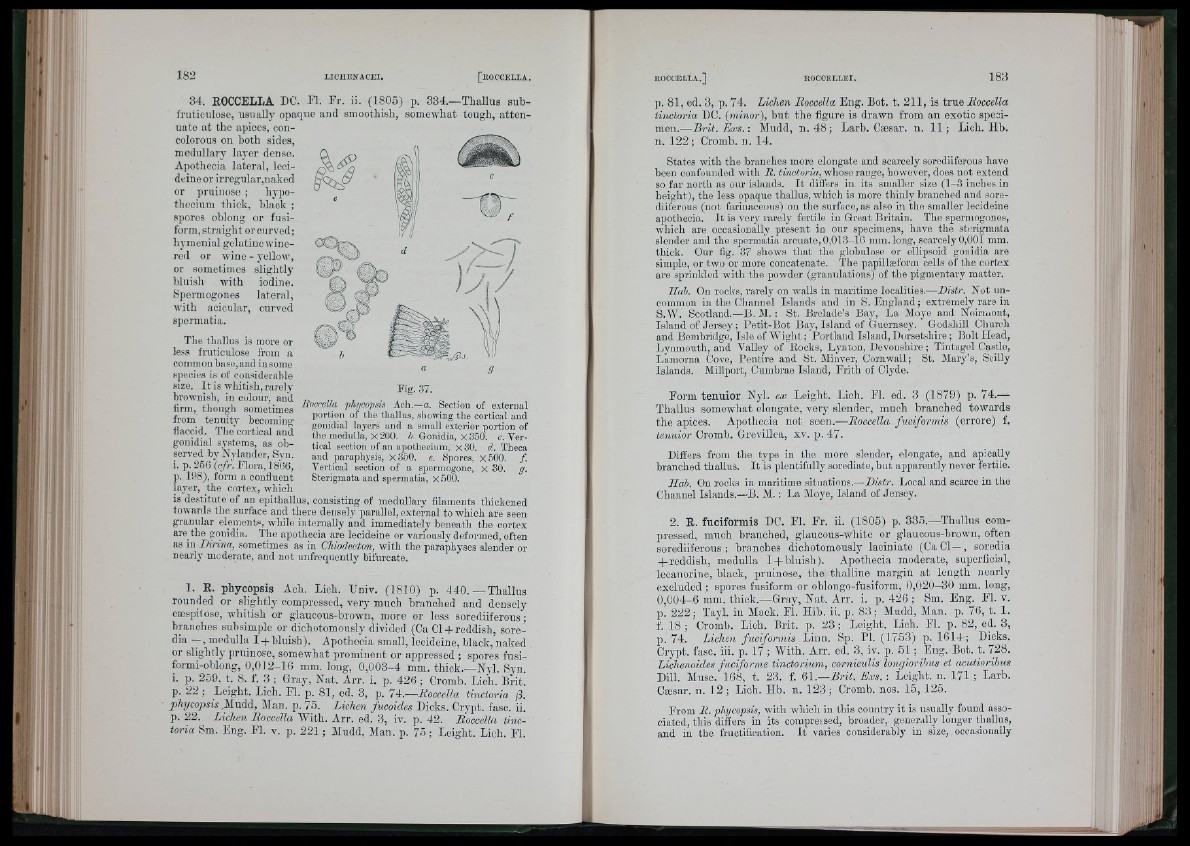
i')
■I
34. EOCCELLA DC. F l. F r. ii. (1805) p. 334.—Thalliis subfruticulose,
usuallj' opaque and smoothish, somewhat tough, a tte n uate
at the aj)ioes, concolorous
on both sides,
niedullaiu’ layer dense.
Aqiothecia lateral, Icoi-
dcine or irregular,naked
or pruiiiose ; hypo-
tliecium thick, black ;
spores oblong or fusiform,
straight orciirved;
hymenial gelatine wine-
red or wine - yellow,
or sometimes slightly
bluish with iodine.
Spermogones lateral,
with acioular, curved
spermatia.
The tliallus is more or
le.is fruticulose from a
common base,and insonie
species is of considerable
size. I t is wliitish, rarelv
brownish, in colour, and
linn, though sometimes
from tenuity becoming
flaccid. Tbe cortical and
gonidial systems, as observed
by Nylander, Syn.
Fig. 37.
Boccella phycopsis Ach.—a. Section of external
portion of the thallus, showing tbe cortical and
gonidial layers and a small exterior portion of
the medulla, x200. h. Gonidia, X850. c. Vertical
section of an apothecium, x30. d. Theca
and paraphysis, X3o0. e. Spores, x500. /.
Vertical section of a spei mogone, X 30. g.
Sterigmata and spermatia, X 500.
i. p. 256 (cfr. Flora, 1866,
). 198), form a confluent
aver, the cortex, which
is destitute of an epitliallus, consisting of medullary fllaments thickened
towards tbe surface and there densely parallel, external to which are seeu
granular elements, while internally and immediately beneath the cortex
are the gonidia. The apothecia are lecideine or variously deformed, often
as in Dirina, sometimes as iu Chiodecton, with the paraphyses slender or
nearly moderate, and not unfrequently bifurcate.
1. E. phycopsis Ach. Lioh. Univ. (1810) p. 440. — Thallus
rounded or slightly compressed, very much branched and densely
caispilose, whitish or glaucous-brown, more or less sorediiferous;
branches suhsimple or dichotomously divided (Ca Cl + reddish, sore?
dia —, medulla I-(-bluish). Apothecia small, lecideine, black, naked
or slightly pruinose, somewhat prominent or appressed ; spores fusiformi
oblong, 0 ,0 1 2 -1 6 mm. long, 0 ,0 0 3 -4 mm. thick.—Nyl. Syn.
i. p. 259, t. 8. f. 3 ; Gra)', Nat. Arr. i. p. 4 2 6 ; Cromb. Lich. Brit,
p. 22 ; Leight. Lich. F l. p. 81, ed. 3, p. 14.— Hoccdla tinctoria p.
phycopisis.Aludd, Alan. p. 75. Lichen fucoides Dicks. Cryqit. fasc. ii.
p. 22. Lichen Boccella With. Arr. ed. 3, iv. p. 42. Eoccella line-
toria Sm. Eng. Fl. v. p. 2 2 1 ; Aludd, Alan. p. 7 5 ; Leight. Lich. Fl.
p. 81, ed. 3, p. 74. Lichen Boccella Eng. Bot. t. 211, is tru e Eoeoella
tinctoria DC. (minor), b u t the figure is drawn from an exotic specimen.—
B r it. Exs. : Aludd, n. 48 ; Larb. Cæsar. u. 11 ; Lich. Hb.
n. 122 ; Cromb. n. 14.
States with the branches more elongate and scarcely sorediiferous have
been confounded with R. iiVieiocfa, whose range, however, does not extend
so far north as our islands. I t differs in its smaller size (1-8 inches in
height), the less opaque thallus, which is more thinly branched and sorediiferous
(uot fiirinaceons) on the surface, as also in the smaller lecideine
apothecia. I t is very rarely fertile in Great Britain. The spermogones,
which are occasionally present in our specimens, have the sterigmata
slender and the spermatia arcuate, 0,018-16 mm. long, scarcely 0,001 mm.
thick. Our fig. 37 shows that the globuloso or ellipsoid gonidia are
simple, or two or more concatenate. The papiUæform cells of the cortex
are sprinkled with the powder (granulations) of the pigmentary matter.
Ilah. On rocks, rarelv on w'alls in maritime localities.—Distr. Not uncommon
iu the Channel Islands and in S. England; extremely rare in
S.W. Scotland.—B.AL: St. Brelade’s Bay, La Aloye and Noirmont,
Island of Jersey ; Petit-Bot Bay, Island of Guernsey. Godshill Church
and Bern bridge, Isle of AATght; Portland Island, Dorsetshire ; Bolt Head,
Ijjmmouth, and A’alley of Rocks, Lynton, Devonshire ; Tintagel Castle,
Lamorna Cove, Pendre and St. Minver, Cornwall; St. Alary’s, Scilly
Islands. Alillport, Ciimhrae Island, Frith of Clyde.
Form tenuior Nyl. ex Leight. Lioh. Fl. ed. 3 (1879) p. 74.—
Thallus somewhat elongate, very slender, much branched towards
th e apices. Apothecia not seen.—Boccella fuciformis (errore) f.
tenuior Cromb. GreviUea, xv. p. 47.
Differs from the type iu the more slender, elongate, and apically
branched thallus. I t is plentifully sorediate, but apparently never fertile.
Hab. On rocks in maritime situations.—Distr. Local and scarce in the
Channel Islands.—B. AI. ; La Aloye, Island of Jersey.
2. E . fuciformis DO. F l. F r. ii. (1805) p. 335.—Thallus compressed,
much branched, glauoous-wliite or glaucous-brown, often
sorediiferous; branches dichotomously laciniate (CaCl—, soredia
-fred d ish , medulla I-|-b lu ish ). Apothecia moderate, superficial,
lecanorine, black, pruinose, th e thalline margin a t length nearly
excluded ; spores fusiform or oblongo-fusiform, 0,0 2 0 -3 0 mm. long,
0 ,0 0 4 -6 mm. thick.— Gray, Nat. Arr. i. p. 426 ; Sm. Eng. Fl. v.
p. 2 2 2 ; Tayl. in Alack. Fl. Hib. ii. p. 8 3 ; Aludd, Alan. p. 76, t. 1.
f. 18 ; Cromb. Lioh. Brit. p. 23 ; Leight. Lioh. Fl. p. 82, ed. 3,
p. 74. Lichen fucifo rm is Linn. Sp. PI. (1753) p. 1 6 1 4 ; Dicks.
Crypt, fasc. iii. p. 17 ; YTth. Arr. ed. 3, iv. p. 51 ; Eng. Bot. t. 728.
Lichenoides fu c iforme tinctorium, corniculis longiorihus et acutioribus
Dill. Muse. 168, t. 23. f. 61.— B rit. Exs. ; Leight. u. 171 ; Larb.
Cæsar. n. 12 ; Lieh. Hb. n. 1 2 3 ; Cromb. nos. 15, 125.
From R . phycopsis, with wbicb in tins country it is usually found associated,
this differs in its compressed, broader," generally longer thallus,
and in the fructification. I t varies considerably in size, occasionally